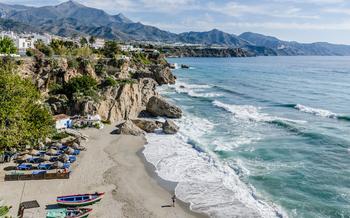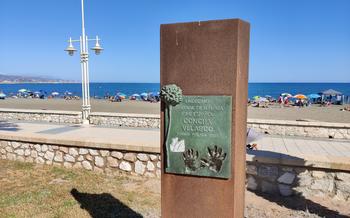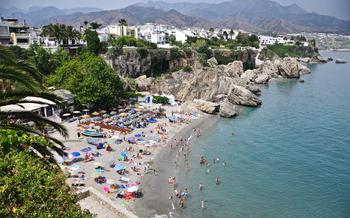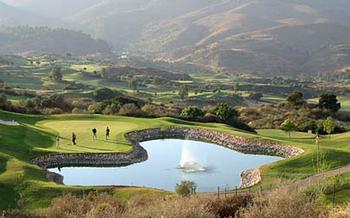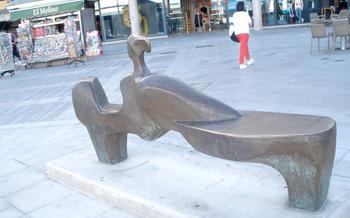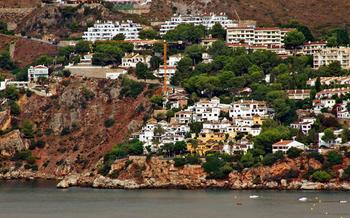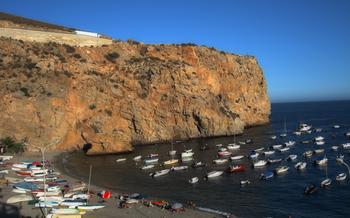
Nerja Caves (Nerja)
- Nerja Caves: A Journey to the Center of the Earth
- Stalactites and Stalagmites: A Symphony of Stone
- The Big Sala: A Cathedral of Nature
- The Column of Hercules: A Pillar of Strength
- The Cave Paintings: A Glimpse into the Past
- The Nerja Museum: Unveiling the Secrets of the Caves
- The Nerja Town: A Cultural Tapestry
- Planning Your Visit: Tips for a Seamless Experience
- Inside the Caves: A Journey Through Time
- The Cave Fauna: Coexisting with Nature
- Sustainable Tourism: Preserving the Caves for Future Generations
- Photo Opportunities: Capturing the Magic
- Accessibility for All: Ensuring an Inclusive Experience
- The Nerja Caves Festival: A Celebration of Art and Culture
- Insider Tip: Explore the Hidden Gems of Nerja
Nerja Caves: A Journey to the Center of the Earth
In the heart of Andalusia, nestled amidst the picturesque landscapes of the Costa del Sol, lies a subterranean wonder that has captivated explorers, scientists, and travelers alike: the Nerja Caves. Discovered serendipitously by a group of local boys in 1959, these caves have since unveiled a treasure trove of geological marvels, prehistoric art, and archaeological significance.
Delving deep into the earth, visitors embark on a journey through time and nature, marveling at the intricate formations of stalactites and stalagmites, the towering chambers adorned with ancient paintings, and the awe-inspiring Column of Hercules. The Nerja Caves offer a glimpse into the lives of our prehistoric ancestors, the secrets of our planet's formation, and the delicate balance of our ecosystems.
Guided tours lead visitors through a labyrinth of chambers and galleries, revealing the hidden wonders of this subterranean realm. Prepare to be mesmerized by the Big Sala, a cathedral-like chamber that echoes with the whispers of time, and stand in awe before the Column of Hercules, a stalagmite of colossal proportions that has become an iconic symbol of the caves.
Whether you are a history buff, a nature enthusiast, or simply seeking an unforgettable adventure, the Nerja Caves beckon you to explore their hidden depths and discover the secrets they hold.
Stalactites and Stalagmites: A Symphony of Stone
Nerja Caves are renowned for their impressive collection of stalactites and stalagmites, which have been formed over thousands of years through a process of water seeping through the limestone rock and depositing calcite. These formations are not only visually stunning but also scientifically significant, providing insights into the geological history of the caves.
Stalactites, which hang from the ceiling, are formed by water dripping and leaving behind calcite deposits. Over time, these deposits grow into long, slender columns, sometimes resembling icicles. Stalagmites, on the other hand, are formed on the cave floor by water dripping from the stalactites. They rise upward, often meeting the stalactites to create impressive columns.
The colors and textures of the stalactites and stalagmites vary depending on the mineral composition of the water and the presence of impurities. Some formations are white and translucent, while others are tinted with shades of yellow, orange, or brown. The variety of shapes and sizes creates a mesmerizing spectacle that leaves visitors in awe.
One of the most remarkable formations in the Nerja Caves is the "Medusa", a stalactite that resembles the mythical creature with its flowing "hair." Another notable formation is the "Elephant's Trunk", a stalagmite that is shaped like an elephant's trunk. These unusual formations add a touch of whimsy and intrigue to the caves.
The Big Sala: A Cathedral of Nature
The Big Sala is the heart of the Nerja Caves, a vast and awe-inspiring chamber that leaves visitors in awe. With a height of 60 meters and a length of 80 meters, it is one of the largest natural chambers in the world. The sheer size and grandeur of the sala create a sense of humility and wonder, making it a truly unforgettable experience.
Discovered in 1959, the Big Sala is adorned with stunning stalactites and stalagmites that have taken millions of years to form. The formations come in various shapes and sizes, creating a surreal landscape that resembles a cathedral of nature. The acoustics within the sala are remarkable, with every sound echoing and reverberating through the chamber.
Ancient paintings and drawings have been found on the walls of the Big Sala, providing a glimpse into the lives of prehistoric inhabitants. These artworks depict animals, humans, and abstract symbols, offering valuable insights into the culture and beliefs of our ancestors.
Legends and stories surround the Big Sala, adding to its mystique and allure. One legend tells of a hidden chamber within the sala, containing a treasure trove of gold and jewels. Another legend speaks of a magical portal that leads to another realm, a place of wonder and enchantment.
The Column of Hercules: A Pillar of Strength
The Column of Hercules stands as a majestic natural monument within the Nerja Caves. This towering stalagmite, measuring an impressive height of 33 meters, is a testament to the relentless forces that have shaped this subterranean wonderland. Its name evokes the mythical pillars that marked the entrance to the Mediterranean Sea in ancient Greek mythology, symbolizing strength and endurance.
Formed over millions of years by the slow and steady accretion of calcium carbonate, the Column of Hercules embodies the essence of geological perseverance. Its composition, primarily calcite, contributes to its remarkable resilience and durability. The column's towering presence commands awe and wonder, a testament to the intricate processes that have crafted the Nerja Caves.
Myths and legends have intertwined with the history of the Column of Hercules, adding layers of intrigue to its significance. In ancient times, it was believed to be a marker for sailors navigating the treacherous waters of the Mediterranean. Mariners sought guidance from the column, which symbolized the gateway to new horizons and the promise of safe passage.
The Column of Hercules remains a symbol of strength and resilience, standing as a testament to the enduring power of nature. Its presence within the Nerja Caves invites visitors to contemplate the vastness of geological time and the interconnectedness of the natural world.
The Cave Paintings: A Glimpse into the Past
The Nerja Caves are not only renowned for their geological formations but also for the impressive collection of cave paintings that adorn their walls. Discovered accidentally in 1959, these paintings offer a unique glimpse into the lives and beliefs of our prehistoric ancestors.
Created using natural pigments and charcoal, the paintings depict a variety of subjects, including animals, humans, and abstract symbols. The most notable among them is the "Hunting Scene," which portrays a group of hunters pursuing a herd of ibex. The vividness of the figures and the intricate details suggest a high level of artistic skill and storytelling ability.
The paintings are believed to date back to the Upper Paleolithic period, around 42,000 to 10,000 years ago. Their discovery has provided valuable insights into the cultural practices, rituals, and beliefs of the early inhabitants of the region.
The cave paintings in the Nerja Caves are not only aesthetically stunning but also hold immense scientific and historical significance. They offer a tangible connection to our past and provide a fascinating glimpse into the minds and imaginations of our ancestors.
The Nerja Museum: Unveiling the Secrets of the Caves
Nerja Museum stands as a treasure trove of knowledge, inviting visitors to delve deeper into the fascinating world of the Nerja Caves. Through captivating exhibits and displays, the museum unveils the rich history and significance of these natural wonders. Artifacts, fossils, and tools discovered within the caves paint a vivid picture of the lives of prehistoric inhabitants. Interactive displays and educational programs provide an immersive experience, allowing visitors to gain a profound understanding of the geological processes that shaped the caves and the cultural significance they hold. For history and archaeology enthusiasts, the Nerja Museum is an unmissable destination, offering a chance to uncover the hidden secrets of these ancient chambers.
The Nerja Town: A Cultural Tapestry
Nestled along the picturesque Costa del Sol, the town of Nerja exudes a charm that blends history, culture, and natural beauty. Its cobbled streets, whitewashed buildings, and vibrant plazas create a welcoming atmosphere that invites exploration.
Nerja boasts a rich cultural heritage, with roots dating back to ancient civilizations. The town's historical legacy is evident in its many monuments and landmarks, including the Church of El Salvador, built in the 16th century, and the ruins of the Castillo de Nerja, a Moorish fortress that once guarded the town from invaders.
Throughout the year, Nerja comes alive with traditional festivals and events that showcase its vibrant culture. The most famous of these is the Feria de Nerja, held in October, which features colorful parades, live music, dancing, and traditional Andalusian cuisine.
Nerja's culinary delights are not to be missed. Fresh seafood, locally grown produce, and traditional Spanish dishes are celebrated in the town's many restaurants and tapas bars. Indulge in the flavors of paella, gazpacho, and pescaíto frito (fried fish) while enjoying the warm hospitality of the local people.
Whether you're seeking historical charm, cultural immersion, or culinary adventures, Nerja offers a tapestry of experiences that will leave you enchanted.
Planning Your Visit: Tips for a Seamless Experience
To ensure a smooth and memorable visit to the Nerja Caves, careful planning is essential. Firstly, consider the weather conditions when choosing your visit date. The caves maintain a constant temperature and humidity, but the outside weather can impact your overall experience. Spring and autumn offer pleasant temperatures, while summer can be hot and crowded.
Advance ticket reservations are highly recommended, especially during peak tourist season. This allows you to avoid long queues and guarantees your entry. Online booking platforms and the official website of the caves provide convenient options for purchasing tickets.
Guided tours are an excellent way to delve deeper into the history, geology, and significance of the Nerja Caves. Knowledgeable guides provide insightful commentary and can answer any questions you may have. Tours are available in multiple languages, ensuring accessibility for visitors from diverse backgrounds.
For visitors with disabilities, the Nerja Caves offer accessible pathways and ramps, making it easy to explore the caves in a wheelchair or with a stroller. Braille signs and audio guides are also available for visually impaired visitors, enabling them to fully experience the caves' wonders. The staff at the caves is always willing to assist and accommodate visitors with special needs, ensuring an inclusive and enjoyable experience for all.
Inside the Caves: A Journey Through Time
Venturing inside the Nerja Caves is akin to embarking on a journey through time. The temperature remains a constant 19 degrees Celsius, and the humidity hovers around 90%, creating a cool and refreshing atmosphere. Pathways and staircases, illuminated by strategically placed lights, guide visitors safely through the vast chambers and corridors.
Exploring the caves with an audio guide or a knowledgeable tour guide enhances the experience, providing insights into the geological formations, the history, and the significance of the cave paintings. These guides bring the caves to life, narrating tales of the prehistoric inhabitants and the explorers who first discovered this subterranean wonderland.
Photography enthusiasts can capture the ethereal beauty of the caves, but flash photography is strictly prohibited to preserve the integrity of the delicate formations. The darkness and low-light conditions require careful adjustments to camera settings, making the use of a tripod highly recommended.
Exploring the Nerja Caves is not just a journey through space but also a journey through time, connecting visitors to the distant past and offering a glimpse into the lives of our ancestors who once inhabited these caverns.
The Cave Fauna: Coexisting with Nature
The Nerja Caves are not just a geological wonder, but also a home to a diverse array of cave-dwelling creatures. These resilient species have adapted to the unique conditions of the caves, showcasing remarkable survival strategies. Among the most prominent inhabitants are bats, which play a crucial role in the ecosystem. These fascinating creatures navigate the darkness with echolocation, effortlessly hunting for insects and contributing to the delicate balance of the cave's environment.
Beyond bats, other unique species have found refuge within the caves, including cave crickets, blind cave spiders, and cave beetles. These creatures have evolved specialized features, such as elongated antennae and heightened senses, to thrive in the darkness. Their presence adds to the biodiversity of the Nerja Caves, highlighting the interconnectedness of life within this subterranean realm.
To ensure the well-being of this fragile ecosystem, conservation efforts are paramount. Strict regulations limit the number of visitors allowed in the caves, and artificial lighting is carefully controlled to minimize disturbance. Moreover, educational programs and guided tours emphasize the importance of responsible behavior, fostering a sense of respect for the delicate balance of life within the caves.
Sustainable Tourism: Preserving the Caves for Future Generations
The Nerja Caves, with their delicate ecosystem and unique geological formations, require responsible tourism practices to ensure their preservation for future generations. Limiting the number of visitors through timed ticketing and controlled access helps minimize the impact on the caves' environment. Educating visitors about the importance of conservation and providing guidance on responsible behavior within the caves are essential. Supporting local initiatives that promote sustainability, such as waste management and energy efficiency measures, contributes to the long-term protection of the caves and their surroundings. By adopting sustainable tourism practices, visitors can actively contribute to the preservation of this natural wonder for generations to come.
Photo Opportunities: Capturing the Magic
The Nerja Caves provide countless opportunities for capturing stunning photographs that will preserve the memories of your visit. To ensure the best results, consider bringing a camera with manual settings or a smartphone with a good camera. Adjust your camera settings for low-light conditions, using a tripod to stabilize your shots and avoid camera shake. Flash photography is not allowed inside the caves, as it can damage the delicate formations. Instead, use natural light or experiment with different lighting techniques to create dramatic and artistic effects. Share your photos with friends, family, and the online community to inspire others to visit this incredible natural wonder. Your images can serve as a visual testament to the beauty and majesty of the Nerja Caves, encouraging others to explore this subterranean paradise for themselves.
Accessibility for All: Ensuring an Inclusive Experience
The Nerja Caves are committed to providing an inclusive and accessible experience for all visitors. To ensure that everyone can enjoy the wonders of the caves, accessible pathways and ramps have been installed to accommodate wheelchairs and strollers. Braille signs and audio guides are available for visually impaired visitors, enabling them to navigate the caves and learn about their history and significance. Additionally, special tours and programs are organized for visitors with disabilities, providing personalized assistance and ensuring a memorable experience for all. The Nerja Caves strive to create a welcoming and inclusive environment where everyone feels comfortable and respected, allowing them to fully immerse themselves in the beauty and wonder of this natural marvel.
The Nerja Caves Festival: A Celebration of Art and Culture
The Nerja Caves Festival is an annual event that celebrates the cultural and artistic significance of the caves. Held during the summer months, the festival transforms the caves into a vibrant venue for performances, exhibitions, and events. Visitors can enjoy concerts, dance shows, theater productions, and art installations, all set against the backdrop of the stunning cave formations.
The festival is a unique opportunity to experience the caves in a different light, as the darkness is illuminated by colorful lights and the sounds of music fill the air. It's a magical and immersive experience that allows visitors to connect with the history and culture of the region in a truly special way.
To make the most of the festival, plan your visit in advance and check the festival program to see which events and performances interest you. Arrive early to avoid lines and secure a good spot for the shows. And remember to bring your camera to capture the beauty of the caves and the festival atmosphere.
Insider Tip: Explore the Hidden Gems of Nerja
Nerja, beyond its famous caves, offers a wealth of hidden gems waiting to be discovered. Lose yourself in the labyrinthine streets of its historic center, where whitewashed houses adorned with colorful flowers line cobblestone lanes. Admire the architectural wonders of the 17th-century El Salvador Church and the 19th-century Balcón de Europa, a scenic viewpoint overlooking the Mediterranean Sea.
Embrace the coastal charm of Nerja by exploring its pristine beaches. Burriana Beach, with its golden sands and crystal-clear waters, beckons sun-seekers and water enthusiasts. Indulge in water sports like snorkeling, diving, and kayaking, or simply relax on the shore, soaking up the warm Spanish sun.
Savor the authentic flavors of Nerja's cuisine at local restaurants and tapas bars. Sample the freshest seafood dishes, such as pescaíto frito (fried fish) and espetos de sardinas (grilled sardines), prepared with local ingredients and infused with Mediterranean flavors. Treat your palate to the region's renowned wines, produced in the nearby Axarquía region, and experience the vibrant culinary scene of Nerja.
As the sun sets, Nerja transforms into a lively hub of entertainment. Experience the infectious rhythm of flamenco at local tablaos, where passionate performances showcase the art of dance and music. Mingle with locals and fellow travelers at the many bars and pubs, enjoying live music, delicious cocktails, and the warm ambiance of this charming town.
Nerja offers a harmonious blend of history, nature, and culture, ensuring an unforgettable experience for every visitor. Whether you seek relaxation, adventure, or cultural immersion, this vibrant town has something to offer. Embrace the local spirit, explore its hidden gems, and create lasting memories in this enchanting corner of Spain.
